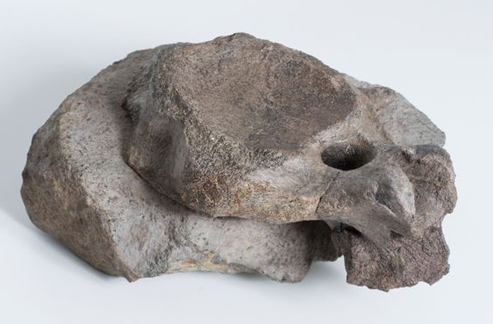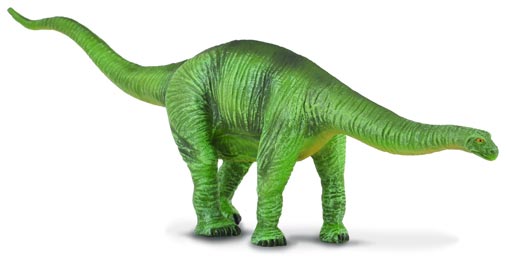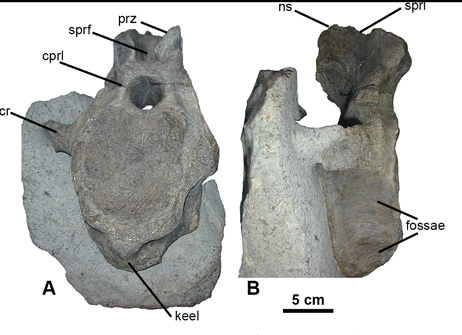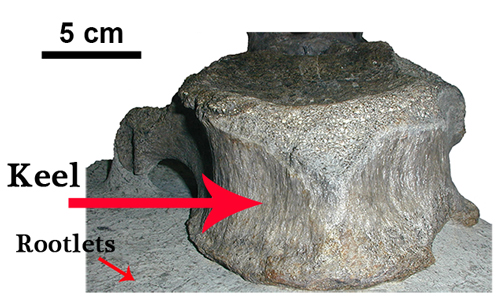A New Sauropod Dinosaur from the Middle Jurassic
Here is a tale of a tail bone from the United Kingdom, one that once formed part of the skeleton of a primitive sauropod that lived in Yorkshire some 176 million years ago. It fell out of a cliff and was found on the beach close to the north Yorkshire coastal town of Whitby, not too far away from the famous Abbey. The fossil was sent to the University of Manchester for further study and detailed X-ray computer tomography analysis was undertaken at the nearby Manchester Royal Infirmary (Dept. of Radiology) in a bid to learn more about the specimen.
The fossil represents a caudal vertebra (a tail bone) one that would have been located in the long tail but near to the hips.
Britain’s Oldest Sauropod
Team members at Everything Dinosaur have seen this specimen up close. We were shown the fossil on a visit to Manchester University some years ago by Professor Phil Manning. A paper detailing this discovery has been published in the journal PLOS One, Professor Phil Manning co-authored this paper along with colleague Victoria Egerton (School of Earth, Atmospheric and Environmental Sciences) with the help of Mike Romano, an independent researcher based in Sheffield (South Yorkshire).
The Sauropod Dinosaur Tail Bone
Picture credit: Manchester University
An Indeterminate Sauropod Caudal Vertebra
The picture above shows the indeterminate sauropod caudal vertebra, the face of the centrum can clearly be seen as can the hole in the bone which represents the neural canal where the spinal cord passed through. The specimen is significant as it comes from the Saltwick Formation which forms one of the oldest sequences of rock from the Ravenscar Group of largely terrestrial deposits laid down in an estuarine environment.
Very few body fossils have been found in these rocks, but a number of dinosaur trackways have been described. These tracks represent a number of different types of dinosaur, theropods, stegosaurs, ornithopods and long-necked dinosaurs – sauropods. The strata was formed around 176 million years ago (Aalenian faunal stage ) of the Middle Jurassic. This fossilised bone is therefore the oldest sauropod fossil scientifically described from the British Isles. It is some 4 million years older than the Cetiosaurus spp. material which has been described from strata laid down during the Bajocian and Bathonian faunal stages of the Jurassic.
A New Species
It most certainly represents a new species and the specimen had been nick-named “Hildasaurus” after St Hilda, the abbess who founded Whitby Abbey on the East Cliff overlooking the town. However, due to the very low number of sauropod caudal vertebrae that have been described from the Middle Jurassic, it is not possible to assign this fossil to a new species and to give the dinosaur bone a binomial scientific name.
A Typical Cetiosaurid Sauropod Dinosaur
Picture credit: Everything Dinosaur
Professor Manning explained:
“It was a splendid surprise to come face-to-face with a fossil vertebra from the Jurassic rocks of Yorkshire that was clearly from a sauropod dinosaur. This fossil offers the earliest “body fossil” evidence for this important group of dinosaurs but it’s impossible to define a new species based on this single bone.”
Views of the Caudal Vertebra (Specimen Number: YORYM: 2001.9337)
Picture credit: PLOS One
“Hildasaurus”
The picture above shows two further views of the fossil material (A) oblique view (photograph taken at an angle, not quite an anterior view), which shows a distinct keel on the bottom of the bone and a partial caudal rib (CR) that can be seen on the left of the bone.
Key (Picture A)
PRZ = prezygapophysis – a peg of bone located on the neural arch which articulates with the next tail bone in the caudal vertebrae sequence.
SPRF = spinoprezygapophyseal fossa – a channel in the reinforcing ridge of bone commonly associated with sauropod vertebrae that strengthens the connection between the bones
CPRL = centroprezygapophyseal lamina – the ridge of bone the connects the centrum with the prezygapohysis at the top of the vertebra
CR = caudal rib – one of a pair of thin, struts of bone that point out at roughly ninety degrees to the face of the centrum. These small bones support tail muscle attachments.
KEEL = keel – describes the shape of the bone at the base of the centrum.
Not an Example of Cetiosaurus
Although the fossil bone is not complete, these features have helped the scientists to determine that this specimen, most probably does not represent a Cetiosaurus. Caudal tail bones located relatively close to the hips, such as those fossils assigned to the “Rutland Cetiosaurus” lack the keel shaped portion of bone on the ventral face of the vertebra. In addition, the fragment of caudal rib present in the specimen is located at a different position in relation to the centrum when compared to the caudal ribs found on cetiosaurid fossil material.
Picture B shows a lateral view (a view of the right side of the fossil). The shape of the neural spine (NS) can be clearly seen in this view.
Key (Picture B)
NS = neural spine, a blade shaped bone projection that sits on top the neural arch.
SPRL = spinoprezygapophyseal laminae – a ridge of bone that strengthens the connection between the neural with one of the prezygapophyses.
FOSSAE = recessed areas or depressed areas of bone (single = fossa).
In both picture A and B, the scale bar is 5 cm.
Although, the caudal vertebra is similar to that found in Cetiosaurus spp. and has some potential affinity with another sauropod called Haplocanthosaurus (Upper Jurassic Morrison Formation of the United States), the morphological differences described indicate that this fossil bone does represent a new, as yet undescribed species of long-necked, Middle Jurassic dinosaur.
A Close up View of the Sauropod Fossil showing the Distinctive Keel
Picture credit: PLOS One with additional annotation from Everything Dinosaur
Pointed Keel Representing Britain’s Oldest Sauropod
The pointed keel shape can be made out in this ventral view (photograph above). The density of the surrounding matrix made CT interpretation difficult but enough of the fossil bone has been prepared to confirm the sauropod diagnosis but genus level or even family level identification is not possible. Fossilised fragments of plant rootlets and other material has helped the palaeontologists to identify the origins of this fossil, even though it was found on the beach having eroded out of the cliff face.
The lack of abrasion (erosion) on any of the exposed faces suggests that this fossil was not transported far prior to burial, or indeed, that the fossil material had not been exposed on the shore for very long prior to its discovery.
This discovery gives team members at Everything Dinosaur the opportunity to applaud the hard-working team of scientists (both amateur and professional) that so conscientiously dedicate so much time to the exploration and study of the many important geological sites in the British Isles. It was Alan Gurr who actually found this proximal caudal vertebrae on a field trip led by Professor Phil Manning.
The specimen (YORYM:2001.9337), may not be able to be assigned to a species, but the fossil was nick-named “Alan” in honour of the finder. The very talented Mike Marshall of Yorkshire Coast Fossils was responsible for preparing the vertebrae and such careful preparation permits a rare insight into the ancient fauna of the Jurassic.










Leave A Comment